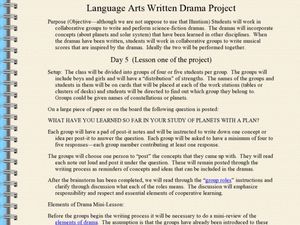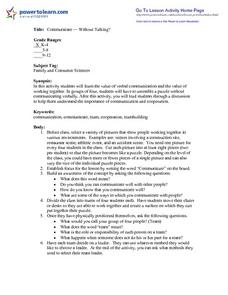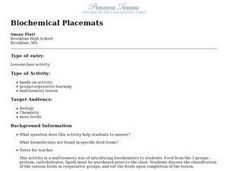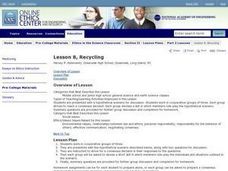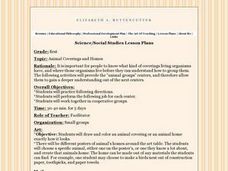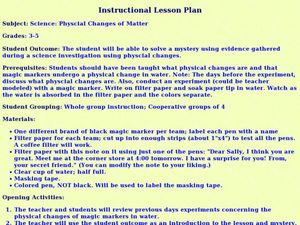Curated OER
Language Arts: Ode to the Ordinary
Eighth graders select ordinary objects, determine their uses, and write poems about them. Once they select an object, they create a web about its uses to serve as an outline. Once they have written their own odes, 8th graders meet in...
Curated OER
Put Your Truss in Building Bridges
Learners apply abstract concepts, such as stress, fulcrums, the law of gravity, and the strength of different geometric shapes. Groups of student contractors operate simulated architectural firms to create strong, economical bridges.
Curated OER
Rollin' On
Third graders investigate the effects of gravity on the motion of a marble on an inclined plane and a declined plane. They work in small cooperative groups to predict and explain outcomes.
Curated OER
Where Have All the Wetlands Gone?
Students investigate the wetlands. In this environmental conservation lesson, students discuss the characteristics of wetlands and identify their location. Students work in cooperative groups to complete a handout.
Curated OER
Language Arts Written Drama Project: Creationism
Students create and perform science fiction drams based upon their knowledge of the solar system. In this solar system lesson students work in cooperative groups to create a short play and will also score the play.
Curated OER
Wish You Were Here - Research Conditions on Mars
High schoolers research conditions on Mars, then create a travel brochure or presentation to attract tourists. They work in cooperative groups. Each member is assigned a different role and contribute specific information to the group's...
Curated OER
Land Biomes Research and Presentation
Fifth graders work in cooperative groups to research an assigned land biome using various sources. Groups create either a book or a PowerPoint presentation of their assigned land biome.
Curated OER
Communicate - Without Talking?
Students discuss and define communication and identify different ways of communicating with people. Students then practice team building and non-verbal communication skills as they work silently in small teams to put puzzles together.
Curated OER
Living On Earth
Learners discover the many different animals within various habitats and discover how each individual species interacts with its particular environment. Through charting different animals and their distinct habitat and matching animals...
Curated OER
Magnets
Second graders participate in a teacher demonstration of the polarity of magnets. They observe how magnets repel and attract items before drawing their observations on worksheets. They manipulate the donut magnets, discuss their action...
Curated OER
Blue Genes: Affect Your Life!
Students, in groups, research, analyze and synthesize information on genetic diseases. After watching a video on genetics, groups perform research on a variety of genetic diseases and present their findings to the class.
Curated OER
Biochemical Placemats
Students group various foods according to whether they are proteins, carbohydrates, or lipids. This activity is a multisensory way of introducing students to biochemistry. Students also learn how icons represent the molecular composition...
Curated OER
Flower Reproduction
Fifth graders examine the cycle of flower reproduction. They listen to a poem about a bee, observe and examine flowers in small groups, and develop a class KWL chart. Students then read about flower reproduction in their textbook, and...
Curated OER
Clustering
Fifth graders are introduced to the concept of clustering. In groups, they use their new science vocabulary words to put into a web or cluster. To end the lesson, they read a book related to electricity and write the definitions of any...
Curated OER
The Polymer Schoolhouse
Students study various objects and determine plastic and non-plastic. In this creative instructional activity students get into groups and create a diorama to show the different properties they discovered.
Curated OER
Lesson 8, Recycling
Students examine recycling. In this environmental stewardship lesson, students practice persuading others to recycle as they collaborate to prepare small group skits. Students discuss the issue and write reflections about the experience.
Alabama Learning Exchange
It's a Small, Small World
Students compare and contrast the different characteristics of animal-like, plant-like, and fungus-like protists. They list examples and describe the characteristics shared by the three protist groups. They create a brochure or slideshow...
Curated OER
Cellular Cellebrities
Sixth graders, in groups, learn the morphology and function of organelles within plant and animal cells.
Curated OER
Animal Coverings and Homes
First graders research what kind of coverings living organisms have, and where those organisms live before they can understand how to group them. The following activities will precede the "animal groups" centers, and therefore allow them...
Curated OER
Environment: Renewable Energy Sources
Students, in groups, conduct Internet research on various renewable energy sources. The groups create several multimedia slides for inclusion in a class presentation. Topics covered include solar, nuclear, and geothermal power.
Curated OER
Probability - What Are the Odds?
Young scholars study the concept of probability. In this probability lesson, students define probability and visit an interactive spinner website to learn about theoretical and experimental probability. Young scholars use pennies and...
Curated OER
Fossil Hunt
Young scholars ask questions about the nature of science as they experience a 'Fossil Hunt'. They reconstruct a book that has been literally destroyed, just as the fossil record has been changed by billions of years of geological processes.
Curated OER
Physical Changes of Matter
Students solve a mystery using evidence gathered during a science investigation. In this physical changes lesson, students analyze a note written in marker to determine the physical changes the ink from the pen underwent. Students...
Curated OER
I Wood if I Could
Tenth graders investigate the process of how specific products are made from trees. For this chemistry lesson, groups of students must choose among ice cream, bubble gum, paper, toothpaste and lipstick. They research, design and produce...






